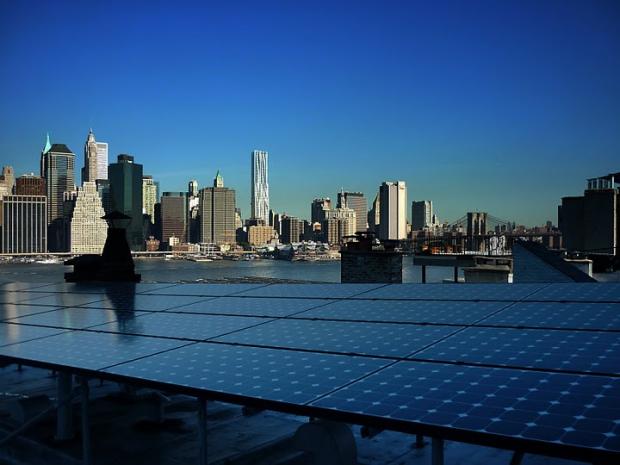Importance of Policy
Innovations in solar photovoltaic technology is continuously occurring in order to improve solar efficiency and reduce consumer costs. However, in order for the solar PV market to maintain and continue its growth, policy is needed to incentivize R&D commercialization [1]. The benefits of solar PV lie in improving energy distribution, domestic energy generation, reducing the grid-load, encouraging private households to consume locally generated power, and fostering “green” jobs [3]. Policies have a key role in increasing deployment of solar PV and decreasing systems’ cost. Meaning, as costs for solar PV systems decrease, solar PV becomes more competitive and as a result, deployment should increase [3]. Additionally, as more solar PV systems are installed, its costs should go down [3, 4].
Solar PVs currently are not cost competitive with most conventional energy sources, hence, cost continues to be the single most significant impediment in solar PV reaching it’s full potential. To date, a large number of installed solar technologies have been due to policy. Studies have shown that the U.S. solar photovoltaic market is driven by federal, state, and local government incentives such as cash rebates, federal and state tax benefits, as well as production-based incentives. Therefore, to assist the solar industry in reaching it’s potential while also achieving great economies of scale, policies must be put in place to create significant cost reductions [3]. Specifically, policies in addition to the ones currently in place are required to attract the necessary increases in investment in technologies and infrastructure [2].
Video accessed through: http://votesolar.org/campaigns/projectpermit/ [4]
Encouraging Legislative and Regulatory Changes
Business models and policies are evolving rapidly to keep up with solar technology innovation. The key to making solar energy an even more successful industry is to not only educate the general public on its benefits and large potential, but also to deliver the benefits of solar photovoltaics to participating customers. In order for this to occur, it is essential for corporations, communities, and governments to share and communicate information on their successful and unsuccessful policies and models. In doing this, the general public and policymakers will better understand the benefits of solar energy production and it will encourage the creation of government policy. Although, it is important to note that policies and programs set in one area may not be effective in another area because of how different each state and territory is from one another. Thus, prior to making legislative or regulatory changes, it is essential that all policy options are explored and considered in light of existing policies and renewable programs. [4]
![Technology development and market deployment are apart of the same joint cycle, supporting one another to achieve the common goal of decreasing technology costs. [4]](http://sites.lafayette.edu/egrs352-sp15-pv/files/2015/05/Screen-Shot-2015-05-03-at-11.45.18-PM.png)
Technology development and market deployment are apart of the same joint cycle, supporting one another to achieve the common goal of decreasing technology costs. [4]
Different Forms of Policies for Solar PV
Financial incentives: investment in solar technology systems more profitable by directly incentivizing businesses and consumers [3, 4]
- Cash incentives— cash rebate or grant
- Income tax incentives— personal or corporate tax credit/deduction
- Sales tax incentives (i.e. Solar Investment Tax Credit)
- Property tax incentives
Command-and-control policies: mandates focusing on increasing the deployment of renewable energy sources [3]
- Renewable Portfolio Standards (RPS)— requires a certain percentage of state electricity sales be generated from renewable energy sources by a specific year
- Mandatory Utility Green Power Options (MUGPO)— requires state utilities to provide “green” electricity generated buying options for their customers
- State Government Green Power Purchasing (SGGPP)— requires for a certain percentage of a state government’s electricity be purchased from renewable energy sources
Support policies: policies focused on removing barriers to renewable energy deployment [3, 4]
- Contractor licensing— licensing available for contractors to ensure proper installation and maintenance
- Equipment certification— predefined standards that renewable energy equipment need to meet
- Solar access— protect consumer’s right to access sunlight
- Net metering— increase deployment of solar PV by allowing electricity to flow in two directions
- Interconnection standards
Examples of State Programs
NOTE: While there are some policies on the federal level, such as income tax incentives, most renewable energy policy action is occurring at the state-level. Given that the effectiveness of solar PVs vary by location, it makes sense for states to differ in policy implementation specifically regarding solar PV systems. [3]
Author: Abby Studen
Editor:Hannah Goldstein
Sources:
[1] “Energy Policies of IEA Countries—The United States 2007 Review.” Joint publication of the International Energy Agency (IEA) and the Organization for Economic Co-Operation and Development (OECD). 2007. Web.
[2] International Panel on Climate Change (2011). IPCC Special report of Renewable Energy Sources and Climate Change Mitigation. P 351. Retrieved from http://srren.ipcc-wg3.de/report/
[3] Shrimali, G. and Jenner, S. “The impact of state policy on deployment and cost of solar photovoltaic technology in the U.S.: A sector-specific empirical analysis.” Renewable Energy 60 (2013): 679-690.
[4] Vote Solar (2015). “Policy Guides”. Web. accessed through http://votesolar.org/policy-guides/

![Summary of State PV Incentive Programs [4]](http://sites.lafayette.edu/egrs352-sp15-pv/files/2015/04/Screen-Shot-2015-05-05-at-5.06.46-PM-copy.png)